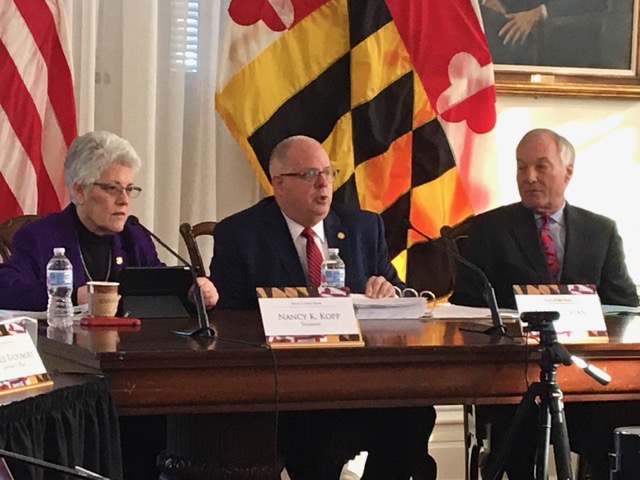
Economics is the study of money in motion. Idle money, or the lack of it, does nobody any good.
Extrapolation is risky business. But it does illustrate that in times of economic distress, government is often the employer of last resort. Having workers on the government payroll as tax-paying citizens is far cheaper and more productive than passing out welfare and unemployment checks.
Thus, it’s rather cheeky of Gov. Larry Hogan (R) to play off government workers against constituent programs and, either way, handing to legislators the dirty work of having to choose which group should bear the brunt of the pandemic’s pandemonium.
Given the same quandary himself at the recent Board of Public Works meeting, Hogan whiffed on whittling the public payroll when he couldn’t muster the necessary two votes. The board’s Democrats – Comptroller Peter Franchot and Treasurer Nancy Kopp – joined in blocking more than $200 million crafted by Hogan as cuts in benefits and pay raises, siding with unions’ vociferous opposition. (Franchot is a declared candidate for governor a couple of years from now.)
As their initial approach, the three members of the BPW, the state’s highest administrative agency, tossed $413 million of Hogan’s suggested $672 million in selective cuts. The cuts included: $3.23 million for violence prevention in Baltimore City; $131.5 million for higher education; and $1.6 million for the Baltimore Symphony.
Pitting highly desirable issues against programs that appear expensive but expendable is part of the dance of legislation, not to belittle the programs that were cut but to dramatize the choices.
Franchot and Kopp, together controlling a majority of votes on the three-member board, forced Hogan to defer trimming the state payroll until the BPW’s next meeting on July 22, one week after the extended deadline for filing tax returns. By then, the final revenue numbers should reveal the state’s projected fiscal position.
To give $672 million some perspective, that’s roughly the amount of annual revenue a penny on the sales tax raises. Now, don’t go getting all wet over that statement. Nobody’s even suggesting an increase in the sales tax. It would be foolhardy to take money out of the economy when the reverse is in order and pump-priming is in overdrive.
But hold your horses! There’s more. Hogan has said that early projections suggest that cuts of $4.6 billion will be needed next year to keep the 2022 budget in balance. That, citizens, is nearly 10 percent of the entire budget of close to $50 billion. He is now talking about serious money.

Frank A. DeFilippo
Moreover, that amount is almost quadruple the state’s current rainy-day fund of $1.2 billion, an amount the appears pretty cushy in flush times but a paltry sum compared to what Hogan’s says will need to be cut.
Other loose change under the sofa cushions includes $129 million in cash reserves, another insignificant amount of money compared to what’s being lost in revenue.
Both those numbers – the rainy-day fund and the cash reserves – exist as shock absorbers, mainly to please the three bond rating houses, Standard and Poor’s, Moody’s and Fitch. The state pays the three roughly $700,000 a year in fees to capture those Triple-A bond ratings.
As a worthwhile footnote, the bond rating agencies used to collect the fees from bond buyers. But back in the late 1970s, they reversed the equation and began charging fees to the bond sellers – states and local governments – and in doing so found a much broader and more willing market and one in search of bragging rights at the head of the alphabet.
As most political hobbyists know, Maryland is among 43 states that require balanced budgets. That durable fable existed only in the minds of those who enforced it until the requirement was finally codified by Constitutional amendment in 1974.
A further safeguard is the executive budget system which gives Maryland’s governor iron-fisted control over the state’s spending program. The system was adopted in 1917 after the General Assembly spent the state into bankruptcy. The legislature can only cut the budget, but cannot increase it or shift money among programs.
Yet there are sneaky ways around the budget restraints, many of which sound good but mean little – the so-called “lockbox,” deficiency appropriations, budget reconciliations, and other asterisks within the budgeting system.
Hogan, who’s nearing the end of his year as chairman of the National Governors’ Association, has been pleading with the Trump administration to double down on financial aid to the states, a suggested figure of around another $500 billion on top of the initial stimulus package of $2 trillion, much of which was divvied up among the states.
Part of the problem is that employment – and state and local revenue along with it – expands and contracts along with the ebb or spread of the coronavirus and its effect on economies. Maryland has been one of the more fortunate states because of its early response and continuing efforts to control the microscopic killer.
A persistent boast has been that Maryland is insulated against the financial fluxions of the national economy because of the diversity of its own economy. But a counterpoint to that structural protection is the other safety valve that fully 25 percent of the state’s workforce is employed by some level of government – federal, state or local. The worse the economy, the greater the demand for government services.
COVID-19 has proven both assumptions wrong. The pandemic has had the opposite effect. It has forced government shutdowns and furloughs to avoid the contagion, cutting into income tax collections and curtailing purchasing power which, in turn, blunts sales tax collections. And the coronavirus is making a ferocious return across the nation due mostly to stupidity, or defiance, which are one and the same, starting at the top.
The nasty little bug has spread its terror through the private sector, as well, through layoffs, cutbacks, furloughs and reductions in pay. Some economists, such as those at the Congressional Budget Office, are now theorizing that it may take a decade to recover from this mess financially.
Tourism, foreign and domestic, is at a standstill, and any businesses built on foot traffic, such as malls, or touristy traps like Baltimore’s Inner Harbor, have suffered losses while on-line shopping has shown a discernible increase. Hit especially hard is the hospitality industry.
There are 477,233 small businesses in Maryland, according to the latest federal figures, some with, and others without, employees. Many have been forced out of business while others are waiting for the cropper to arrive.
All of the negative effects on Maryland’s economy are landing squarely on those who pick up the tab for the services government provides – taxpayers and consumers.
“Taxes,” Oliver Wendell Holmes observed, “are the price we pay for a civilized society.” We’re about to discover in the withholding of many of the programs we enjoy that the taxes we pay for them are worth every penny.
Every program is important to someone, or many someones. The quality of life in Maryland is the sum total of all of those programs.





 Creative Commons Attribution
Creative Commons Attribution